Nikon Digital SLR Camera D2H
July 22, 2003
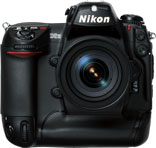

TOKYO -- Nikon Corporation is pleased to announce the introduction of a professional digital SLR camera that delivers high speed, high resolution, and improved handling for action photography: the Nikon D2H.
Since the launch of the D1 series and successful introduction of the Nikon DX Format in September 1999, Nikon has been conducting extensive research into the needs of photographers in every field and discipline. This research, coupled with painstaking analysis of feedback from Nikon users worldwide, has led to a string of technological and design innovations for the Nikon DX Format aimed at enhancing system performance for the serious photographer.
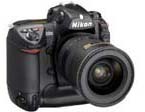
The D2H showcases a skillful integration of such innovations. The first of a new generation of Nikon Digital SLR cameras, the D2H offers an impressive array of exclusive features to improve speed, response, resolution and handling that will establish it as the professional's choice in photojournalism and sports photography.
The D2H is the first digital SLR in the world capable of continuous shooting at 8 frames per second for up to 40 consecutive JPEG or 25 RAW (NEF [Nikon Electronic Image File]) full-resolution (2,464 x 1,632-pixel) images.
Performance is further enhanced by the remarkably short 37ms shutter time lag -- currently the shortest for a Digital SLR -- making the D2H as responsive as the Nikon F5 professional film SLR. Instant power-up means the D2H is ready to shoot as soon as you are.
Together, these high-speed functions give the photographer exceptional control over moving subjects and rapidly unfolding events.
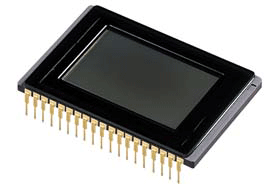
JFET imaging sensor LBCAST
Image resolution of 4.1 effective megapixels was chosen as the right combination for optimum performance on the D2H. Nikon's exclusive new JFET imaging sensor LBCAST combines performance innovations to reduce power consumption and minimize dark noise, all while increasing speed and image quality. The new sensor is built to read 2 channels of data from each pixel at once to achieve maximum speed in image reproduction, while it also eliminates the need for fixed pattern noise correction at power-up to deliver the instant responsiveness professionals need to capture the moment.
The LBCAST imaging sensor also inherits the advantages of the DX Format, bringing together the right combination of high speed, image quality, power efficiency, and optical performance of the lens to realize total system performance. The format also maintains consistency of the angle of view across the Nikon DX Format SLR lineup.
The sensor's thinner Optical Low Pass Filter (OLPF) moreover effectively suppresses moire patterns without compromising the camera's high resolution.
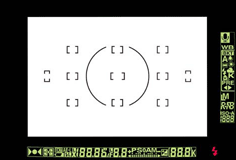
AF system features 11 sensors of which 9 are cross-type
Another milestone technology in the D2H is Nikon's new Multi-CAM 2000 Autofocus (AF) Sensor Module, which ensures quick response and razor-sharp focus in all shooting conditions. This high-speed, high-precision AF system features 11 sensors of which 9 are cross-type sensors that effectively cover the majority of the image area.
The D2H further incorporates image-processing technologies that raise Nikon's Total Image Quality to new heights. The camera's 3D Matrix Image Control delivers subtle color gradations and smooth diagonals, while minimizing the appearance of color fringes and reducing false colors. Thanks to three separate sensors, the D2H achieves highly refined Auto White Balance (AWB) and Auto Tone Control (ATC) under different light conditions. And thanks to Nikon's Color Reproduction System, photographers can also select from three optimized color modes. The result of these innovations is increased versatility, easy-to-use metering, and exceedingly faithful color reproduction with clean, crisp details -- for all subjects and workflow environments.
Despite being a powerhouse of Nikon technologies, the D2H comes in a compact, lightweight, easy-to-handle magnesium alloy body that is tightly sealed to resist exposure to dust and water drops - and sturdy enough to withstand the rigors of globe-trotting photojournalism. Photographers will especially appreciate the large buttons and controls, all logically placed for smooth, intuitive handling. The design of the camera's ergonomic styling is adopted from one created by famed industrial designer Giorgetto GIUGIARO* exclusively for a new generation of Nikon camera.
*![]()
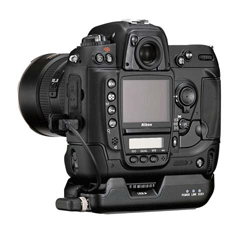
w/ optional Wireless Transmitter WT-1
Other components of the Total Imaging System designed to deliver optimal performance with the D2H have been newly designed or redesigned to expand the shooting and post-processing possibilities.
The new optional Wireless Transmitter WT-1 interfaces directly with IEEE 802.11b compatible access points to realize wireless transfer of image and sound data to FTP servers, and mark a major advance in freeing the photographer's movement and in the ability to deliver timely photos promptly.
The new Nikon Speedlight SB-800 forms the core of the new Creative Lighting System supported by the D2H to add new creative possibilities that are easy to use. The new i-TTL system supports Advanced Wireless Lighting and versatile functions for up to four groups of Speedlights, with 3 remote i-TTL speedlight groups controlled through the master SB-800. New features include advanced i-TTL flash control for optimum results from Auto Balanced Fill-Flash, Flash Value Lock (FV Lock), AUTO FP High-Speed Sync, and a Wide Area AF Assist Illuminator that is tailored to the new D2H's 11-area Multi-CAM 2000 AF Sensor Module.
Nikon Capture 4 is a comprehensive image-editing and remote camera control software package that fully supports NEF (Nikon Electronic image File), TIFF and JPEG images from the D2H. Features of the new version include Image Dust Off sensor dust & particle shade removal control, Digital DEE™ scene-specific automatic dodge and burn control, a transformation function that creates two varieties of ultra-wideangle image from those shot using the AF DX Fisheye-Nikkor 10.5mm f/2.8G ED, as well as improved batch processing.
- Note: Specifications, design, product name and standard accessories may differ by country or area.
Nikon D2H Major Features:
- Unparalleled Speed and Response
-
- Continuous shooting at 8 fps: Continuous shooting at 8 fps for up to 40 consecutive JPEG or 25 RAW (NEF [Nikon Electronic Image File]) full-resolution (2,464 x 1,632-pixel) images.
- 37ms shutter time lag: The 37ms shutter time lag is the shortest in the industry,* and gives the D2H a responsiveness that rivals that of the Nikon F5 professional film SLR.
- Instant power-up: The D2H is ready to take pictures the instant it is turned on.
- *As of Jul. 2003.
- Breakthrough Image Sensing
-
- 4.1 effective megapixels
- New Nikon DX format JFET imaging sensor LBCAST: Nikon's exclusive imaging sensor features higher speed, lower power consumption, and minimal dark noise. The sensor's innovative design also eliminates the need to perform fixed pattern noise correction at power-up.
- Optical Low Pass Filter (OLPF): New, thinner OLPF effectively suppresses moire patterns.
- New Multi-CAM 2000 Autofocus (AF) Sensor Module: The advanced high-speed, high-precision 11-area AF system with 9 cross-type AF sensors ensures quick response and sharp focus regardless of shooting conditions.
- 4 AF Area Modes:
- Single Area AF
- Dynamic AF with Focus Tracking and Lock-on ™
- Closest Subject Priority Dynamic AF
- Group Dynamic AF (New)
- Innovative Image Processing
-
- Improved Processing Algorithm: The advanced image-processing engine features 3D Matrix Image Control and innovative technologies to deliver subtle color gradations, reduce false colors, and minimize the appearance of jaggies on diagonal lines and around color edges.
- Color Reproduction System: A choice of three color modes to best match different subjects, assignment and conditions:
Mode I : Optimized for portraits and natural skin tones (sRGB)
Mode II : Optimized to realize a wide color gamut (Adobe RGB)
Mode III : Optimized for landscapes and flora colors (sRGB) - New JPEG and RAW (NEF) Combination Filing System: The system enables simultaneous recording of RAW (NEF [Nikon Electronic Image File]) and JPEG data for the same shot to the camera's CompactFlash™ or Microdrive™ media to optimize and accelerate workflow operations.
- Precise, easy-to-use Auto White Balance/Auto Tone Control System: The new metering technology combines three separate sensors to realize highly precise Auto White Balance (AWB) and Auto Tone Control (ATC). The system also features new easy-to-use preset WB controls.
- Nikon's acclaimed 1,005-pixel RGB Exposure/Color Matrix Metering Sensor performs direct through-the-lens (TTL) metering of the subject.
- The new LBCAST imaging sensor calculates the lighting characteristics of the actual image to be shot.
- The new external Ambience Light Sensor meters ambient light without being affected by the color of the subject, and distinguishes artificial light from natural light.
- Real-time noise reduction: High-performance real-time noise reduction can be accomplished in a single shot.
- Rugged, Functional Design
-
- Lightweight and durable: The magnesium alloy body is lightweight, durable and compact, combining size and strength in a functional package appreciated by professionals. Dimensions (W x H x D): 157.5 x 149.5 x 85.5 mm / 6.2 x 5.9 x 3.4 in). Weight: Approx. 1,070 g (2.4 lbs.) plus battery (180 g / 6.3 oz.)
- Weather-resistant: The body is specially sealed to be highly resistant to drops of water and dust.
- Operational ease: The large buttons and controls are ergonomically designed and sensibly located to facilitate access and maximize operational ease.
- Reliable shutter unit: The shutter unit is built to endure over 150,000 cycles.
- Extra-large 2.5-inch 211,200-pixel LCD monitor: Located directly below the viewfinder, the high-resolution LCD monitor has a resilient tempered glass surface and offers clear viewing of menus, playback modes, One-touch Zoom, and the new on-demand information.
- Professional-design viewfinder: The eyelevel viewfinder provides virtually 100% frame coverage.
- New lithium-ion battery system: The new Rechargeable Lithium-ion Battery EN-EL4 combines light weight (180g / 6.3oz.), high energy capacity, and improved discharge cycle characteristics for extended battery life. Free of "memory effect," it can be recharged at any time.
- Voice memo: This new feature allows the photographer to record memos up to 60 seconds in length and play them back on the built-in speaker.
- Built-in interval timer: Time-lapse photography uses the D2H's new built-in interval timer.
- Convenient Data Transfer
-
- USB 2.0 (Hi-Speed) interface
- IEEE 802.11b Wireless Transmitter WT-1 (optional): The new wireless transmitter attaches to the camera bottom and connects to the USB port for direct wireless transfer of images to any IEEE 802.11b compatible access point. Maximum range is approx. 150 m (500 ft) with Extended Range Antenna WA-E1. A choice of three security protocols add data protection, while four transmission channels avoid interference and accidental firing.
- Integrated Nikon Software Solutions :
- Nikon Capture 4 (optional): A comprehensive image-editing and remote camera control package that fully supports RAW (NEF)*, TIFF and JPEG data. Among other features, the package offers Image Dust Off sensor dust and particle shade removal control; Digital DEE™ scene-specific automatic dodge and burn control; and transformation of shots from the AF DX Fisheye-Nikkor 10.5mm f/2.8G ED lens to ultra-wideangle images.
- Nikon View 6: Versatile bundled software that simplifies and improves data transfer, as well as browsing and editing of image files.
- *NEF images taken with the D2H are supported by Nikon Capture 4 only.
- Creativity and Versatility
-
- Creative Lighting System: The new i-TTL system supports Advanced Wireless Lighting and versatile functions for up to four groups of Speedlights (3 remote i-TTL Speedlight groups controlled through the master SB-800). The new Nikon Speedlight SB-800 with i-TTL flash control features Flash Value Lock (FV Lock), AUTO FP High-Speed Sync, and Flash Color Information Communication. Also new is the Wide Area AF Assist Illuminator that is tailored to the D2H's new 11-area AF system.
The D2H is also compatible with the D-TTL flash control of Nikon SB-80DX /50DX / (28DX) Speedlights, and with wired multiple flash control. - Lens compatibility: The D2H is compatible with AF Nikkor lenses as well as the new DX Nikkor lenses. Designed specifically for Nikon DX Format digital SLRs, the DX line extends coverage to the ultra-wideangle range while providing high-performance optics in a lightweight, compact design. Two new lenses now join the DX Nikkor range: the AF-S DX Zoom-Nikkor 17-55mm f/2.8G IF-ED and the AF DX Fisheye-Nikkor 10.5mm f/2.8 G ED.
New to the Vibration Reduction Nikkor Lens lineup is the AF-S VR Zoom-Nikkor 200-400mm f/4G IF-ED.
- Creative Lighting System: The new i-TTL system supports Advanced Wireless Lighting and versatile functions for up to four groups of Speedlights (3 remote i-TTL Speedlight groups controlled through the master SB-800). The new Nikon Speedlight SB-800 with i-TTL flash control features Flash Value Lock (FV Lock), AUTO FP High-Speed Sync, and Flash Color Information Communication. Also new is the Wide Area AF Assist Illuminator that is tailored to the D2H's new 11-area AF system.
Nikon D2H Specifications
| Type of Camera | Lens-interchangeable digital SLR camera |
|---|---|
| Effective Pixels | 4.1 million |
| Image Sensor | JFET image sensor LBCAST, 23.3 x 15.5mm size, 4.26 million total pixels |
| Recording Pixels | [L] 2,464 x 1,632-pixel / [M] 1,840 x 1,224-pixel |
| Sensitivity | ISO equivalency 200 to 1,600 (variable in 1/2, 1/3, or 1EV steps), Sensitivity can be extended by 1 or 2 steps beyond ISO 1,600 |
| Storage System | NEF (12-bit RAW uncompressed or lossless compression), Exif 2.2 file (uncompressed TIFF-RGB or compressed JPEG) |
| Storage Media | CompactFlash™ (CF) Card (Type I / II) and Microdrive™ |
| Shooting Modes |
1.)Single frame shooting [S] mode: advances one frame for each shutter release 2.)Continuous high shooting [CH] mode: 8 frames per second (fps) [up to 40 (JPEG) / 25 (RAW:NEF) consecutive shots 3.)Continuous low shooting [CL] mode: 1 to 7 fps (selectable from menus) 4.)Self-timer mode: time duration can be set 5.)Mirror up mode: first press: mirror up, second press: release 6.)Playback mode: Menu mode 7.)PC mode: data transfer via personal computer 8.)Interval timer (Intervalometer) mode provided |
| White Balance |
1.)Auto (hybrid with 1,005-pixel CCD, LBCAST image sensor and external Ambience Light Sensor) 2.)Manual (6 steps with fine tuning) 3.)Preset (5 settings) 4.)Color temperature setting in Kelvin (select from 31steps) 5.)White Balance Bracketing (2 to 9 frames adjustable in 10, 20, 30 MIRED steps) |
| LCD Monitor | 2.5-in., 211,200-dot, low temp. polysilicon TFT LCD with white LED backlighting; Backlight/brightness adjustment available |
| Playback Function | 1.) Full frame, 2.) Thumbnail (4 / 9 segments), 3.) One-touch zoom, 4.) Slideshow, 5.) Histogram indication, and Highlight point display |
| Delete Function | 1) Card format, 2) All frames delete, 3) Selected frames delete |
| Video Output | NTSC or PAL (switchable) |
| Interface | USB 2.0 (Hi-Speed) (Mini-B connector) FTP file transfer available with optional Wireless Transmitter WT-1iIEEE 802.11b) |
| Voice Memo | Record mode: Automatic or manual recording at shooting or playback, Max. Recording time: 60 seconds Playback mode: Built-in speaker or Audio/Video cable File format: Mono WAV file |
| Text Input | Up to 30 characters of alphanumeric text input is available with LCD monitor and multi-selector; stored in Exif header |
| Usable Lenses |
1.)AF Nikkor (including AF-S, DX, VR and D-/G-type) : All functions possible 2.)D-type Manual-Focus Nikkor: All functions except autofocus and some exposure modes available 3.)AF Nikkor other than D-/G-type: All functions except 3D Color Matrix Metering and 3D Multi-Sensor Balanced Fill-Flash possible 4.)AI-P Nikkor: All functions except 3D Color Matrix Metering, 3D Multi-Sensor Balanced Fill-Flash and AF possible 5.)Non-CPU AI Nikkor : Usable in [A] or [M] mode with Matrix-Metering, Center-Weighted and Spot metering available. Indication of aperture No., after user inputs the aperture f/No. and focal length f=mm by multi-selector operation. Electronic Rangefinder usable with maximum aperture of f/5.6 or faster |
| Picture Angle | Approx. 1.5x focal length in 35mm [135] format equivalent |
| Viewfinder | Optical-type fixed eye-level pentaprism; Built-in diopter adjustment (-3 to +1 m-1), Eyepiece shutter provided |
| Eyepoint | 19.9mm (at -1.0 m-1) |
| Focusing Screen | B-type BrightView Clear Matte Screen III; Interchangeable with optional Finder Screen E with grid |
| Viewfinder Frame Coverage | Approx. 100% |
| Viewfinder Magnification | Approx. 0.86x with 50mm f/1.4 lens set to infinity and -1.0 m-1 |
| Reflex Mirror | Automatic, instant-return type |
| Lens Aperture | Instant-return type, with depth-of-field preview button |
| Autofocus | TTL phase detection, Nikon Multi-CAM2000 autofocus module; Detection range: EV -1 to +19 (ISO 100 equivalent, at normal temperature) |
| Lens Servo | 1.) Single Servo AF [S], 2) Continuous Servo AF [C], 3) Manual focus [M] Focus Tracking automatically activated by subject's status in [S] or [C] AF |
| Focus Area | Selectable from 11 focus areas |
| AF Area Mode | 1.) Single Area AF, 2.) Dynamic AF with Focus Tracking and Lock-on™, 3.) Closest Subject Priority Dynamic AF, 4.) Group Dynamic AF |
| Focus Lock | Focus is locked by pressing AE/AF Lock button or lightly pressing shutter release button in [S] AF. |
| Exposure Metering System | TTL full-aperture exposure metering system; 1.)D-/G-type Nikkor lenses support 3D Color Matrix Metering using the 1,005-pixel CCD while other AF Nikkor lenses with built-in CPUs support Matrix Metering (Non-CPU lenses require manual input of lens data) 2.)Center-Weighted Metering (75% of the meter's sensitivity concentrated on the 8mm dia. circle) 3.)Spot Metering (3mm dia. circle, approx. 2% of entire frame); metering position can be linked to the focus area when using Nikkor lenses with built-in CPU |
| Exposure Metering Range |
1.)3D Color Matrix Metering: EV 0 to 20 2.)Center-Weighted Metering: EV 0 to 20 3.)Spot Metering: EV 2 to 20 [at normal temperature (20C / 68F), ISO 100 equivalent, f/1.4 lens] |
| Exposure Meter Coupling | CPU and AI (Automatic maximum aperture Indexing) |
| Exposure Mode |
1.)[P] Programmed Auto (Flexible program possible) 2.)[S] Shutter-Priority Auto 3.)[A] Aperture-Priority Auto 4.)[M] Manual |
| Exposure Compensation | Exposure compensated in +/- 5.0 EV range in 1/3, 1/2 or 1 EV steps |
| Auto Exposure Lock | Detected exposure value locked by pressing AE-L/AF-L button. Number of shots: 2 to 9 frames Compensation steps: 1/3, 1/2, 2/3, or 1EV steps |
| Shutter | Electromagnetically controlled vertical-travel focal-plane shutter, 30 to 1/8,000 s and bulb |
| Sync Contact | X-contact only: flash synchronization up to 1/250 second |
| Flash Control |
1.)New Creative Lighting System: i-TTL Balanced Fill-Flash controlled by five-segment TTL Multi Sensor with Nikon Speedlight SB-800: Advanced Wireless Lighting, FV (Flash Value) -lock, Flash Color Information Communication for Auto White Balance, Auto FP High-Speed Flash Sync, Modeling Flash 2.)D-TTL Balanced Fill-Flash: When used with the Speedlight SB-80DX / 50DX and in accordance with the mounted lens, five-segment TTL Multi Sensor control makes available 3D Multi-Sensor Balanced Fill-Flash, Multi-Sensor Balanced Fill-Flash, and Standard D-TTL Balanced Fill-Flash 3.)AA (Auto Aperture)-type Flash available when used with SB-800/80DX and lens with built-in CPU 4.)Non-TTL Auto Flash (A-type Flash) with a Speedlight such as SB-30 / 27 / 22S etc. |
| Flash Sync Mode | 1.) Front-Curtain Sync (normal sync), 2.) Red-Eye Reduction, 3.) Red-Eye Reduction with Slow Sync, 4.) Slow Sync, 5.) Rear-Curtain Sync |
| Ready-light | Lights up when flash fully charged with Speedlight SB-800 / 80DX / 50DX / 30 / 28 / 27 / 22S; blinks for full output warning |
| Accessory Shoe | ISO 518 standard-type hot shoe contact; Safety lock mechanism provided |
| Sync Terminal | ISO 519 standard terminal, lock screw provided |
| Self-timer | Electronically controlled; Timer duration: 2, 5, 10, and 20 seconds |
| Depth-of-field Preview Button | Stop-down lens aperture by pressing depth-of-field preview button |
| Remote Control | Via 10-pin remote terminal |
| Power Requirements | Rechargeable Li-ion Battery EN-EL4 (11.1V DC), Quick Charger MH-21, AC Adapter EH-6 |
| Tripod Socket | 1/4 in. (ISO1222) |
| Battery Monitoring System | The LCD monitor on the camera back displays the following information about the EN-EL4 battery: 1.) Remaining charge (%); 2.) No. of shots taken since last charge; 3.) Calibration status (Recommended/Not required); 4.) Battery life (5 stages) |
| Dimensions (W x H x D) | Approx. 157.5 x 149.5 x 85.5mm (6.2 x 5.9 x 3.4 in.) |
| Weight (without battery) | Approx. 1,070g (2.4 lbs.) |
| Supplied Accessories* | Rechargeable Li-ion Battery EN-EL4, Quick Charger MH-21, Body Cap, Camera Strap AN-D2H, AV Cable EG-D2, USB Cable UC-E4, LCD Monitor Cover BM-3, Nikon View Software CD-ROM |
| Optional Accessories | Wireless Transmitter WT-1, Extended Range Antenna WA-E1, AC Adaptor EH-6, Interchangeable Focusing Screen E, Antifog Finder Eyepiece DK-16A, Eyepiece Correction Lens DK-16C series, Speedlight SB-800 / 80DX / 50DX, Nikon Capture 4 software, CompactFlash™ card. |
- *Supplied Accessories may differ in each country or area
- CompactFlash™ is a trademark of SanDisk Corporation.
Digital DEE™ is a technology developed by Applied Science Fiction. - Specifications and equipment are subject to change without any notice or obligation on the part of the manufacturer. Jul. 2003
- The information is current as of the date of publication. It is subject to change without notice.
